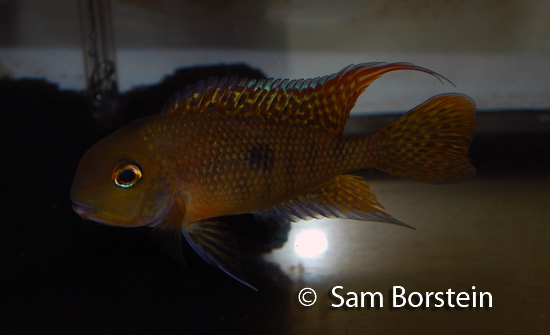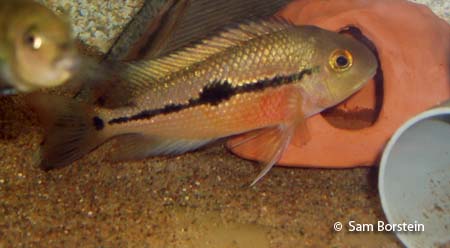Hypsophrys nicaraguensis
(Günther, 1864)
Nics, Macaw Cichlid
Synonyms: Cichlasoma nicaraguensis, Copora nicaragunsis, Hypsophrys unimacaulata

Etymology:
Genus- Hypselos= high (Greek), ophrys= eyebrow (Greek).
Species-nicaraguensis= from Nicaragua.
Intro:
The Macaw Cichlid is a very colorful and popular cichlid in the hobby. This generally peaceful, yet large growing cichlid displays a magnificent assortment of colors, as well as a wide variety of interesting behavior.
This fish, first typed in 1859 by Agassiz as H. unimaculatus, and later by Gunther in 1864 as H. nicaraguensis has been a vagabond in the nomenclature world, traveling from genus to genus. It now resides in Hypsophrys, but has been Cichlasoma, Copora, Heros, and Theraps. It is a monotypic genus.
*Note*- As of August of 2007, Neetroplus has been put into the genus of Hypsophrys. This change was due to the skull structure similarities between the two species. On this site, I still have this fish in Neetroplus because I believe it should be in this genus because of behavior differences and spawning differences. One key factor I see, besides general breeding behavior, is the fact that the eggs of Hypsophrys nicaraguensis are non-adhesive. There are other reasons I have for the keeping of this cichlid in the genus Neetroplus, but that is the major one. I don't think that saying the fish share a similar bone and that they were in sister genera warrants the merging of the two genera. Sure they probably came from a common ancestor, but that doesn't mean they should be in the same genus.
Distribution:
This fish is found in throughout Costa Rica and Nicaragua.
Size, Maturity, and Sexual Dimorphism:
Size: Males- 12 inches, Females- 9 inches
Maturity: 3 inches
Sexual Dimorphism: Males are a little bit larger than females and may develop a hump on their head. They also have longer fin extensions.
Care:
This fish is occasionally aggressive and robust, so give them a big tank. I kept two pairs in a 110 with very few issues. A smaller pair around 3 inches could probably be kept in a 20. This fish does fine in hard water. 50% water changes a week are recommended.
Diet:
Nics are not hard to feed. Feed them foods that will fatten them up quickly. I fed mine all sorts of flake, spectrum, and Tetra cichlid sticks. They are really not picky. In the wild they pick at algae and insect larvae.
Breeding:
Nics are one of the coolest cichlids to watch spawn as they show behavior that is quite unique among cichlids.
Before spawning, the colors of both the male and female intensify and both develop humps on their heads. The pair will pick out a site to spawn, and will defend it.
Nics are unique among cichlids because they are the only substrate spawner with non-adhesive eggs. They roll around the tank, and the parents chase them. In the wild, Dr. Ron Coleman found Nics to be tunnel spawners, digging about 10-20 inches into the sides of clay banks. These nests help the Nics keep their eggs from being taken by the waters strong current.

Above: A female Nic on larvae. Photo by Sam Borstein.
I found the best way to get breed Nics was to feed them a high protein food and a Lamprologus spawning cave. The fish does not have to fit in the cave, as they squirt the eggs into it. This helps contain the eggs and prevents the eggs from being eaten by the other tankmates.
The Macaw cichlid guards its spawn ferociously and makes a wonderful parent. The eggs hatch in about 4 days, and by 7-8 are free swimming. The fry are good sized, easy to raise and grow fast.
Another interesting tidbit about this fish is that in the wild Neetroplus nematopus is a major predator of Hypsophrys nicaraguensis fry. Hypsophrys nicaraguensis have been observed defending Parachromis dovii fry, the main predator of Neetroplus nematopus. It's hypthesized that by helping defend Parachromis dovii fry, there is a greater chance that more Parachromis dovii will reach maturity and more of the Neetroplus nematopus will be eaten, leaving Hypsophrys nicaraguensis with fewer Neetroplus nematopus to compete against.
Conclusion:
Nics are wonderful fish. They are colorful, can be kept in a community tank, and are easy to breed. You can get this fish from hobbyists and may even see it in a pet shop. They are an excellent, beautiful, and undemanding cichlid.
References:
- Bussing, W.A. (1998) Peces de las aguas continentales de Costa Rica. Revista de Biología Tropical, 46, 1–468.
- Schmitter-Soto, J.J., 2007. A Systematic Revision of the Genus Archocentrus (Perciformes:Cichlidae), with the Description of Two New Genera and Six New Species. Zootaxa 1603, 1-76.
